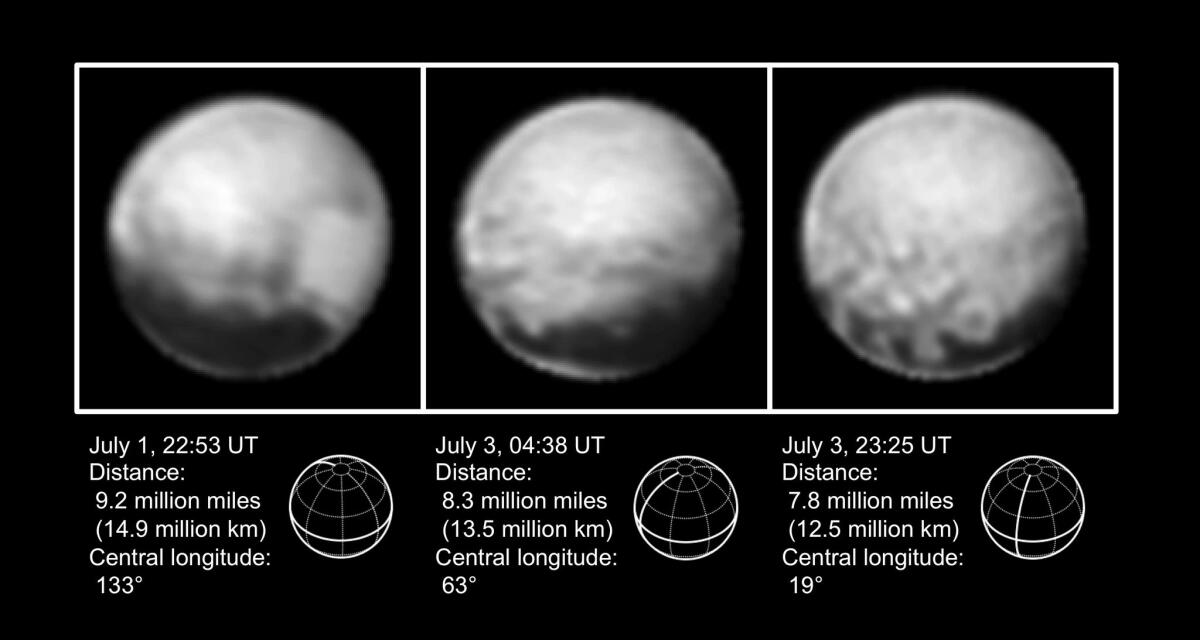Computer glitch doesn’t stop New Horizons: Pluto encounter almost a week away

The latest images of Pluto were taken by NASA’s New Horizons spacecraft just days before it experienced a brief technological glitch.
All systems are go for New Horizons’ flyby of Pluto on July 14, members of NASA’s New Horizons team said two days after a technical glitch caused the spacecraft to briefly lose touch with our planet.
“The spacecraft and all the instruments are operating flawlessly,” New Horizons principal investigator Alan Stern of the Southwest Research Institute said Monday. “We came a long way to explore Pluto and all indications are that Pluto is not going to let us down.”
Stern was joined at a news conference by Jim Green, director of NASA’s Planetary Science division, and Glenn Fountain, New Horizons’ project manager, to explain why the spacecraft lost contact with Earth for approximately 90 minutes on July 4.
Fountain said the glitch occurred when the ground team asked the primary computer on the New Horizons spacecraft to do two things at once. Command instructions for the nine-day encounter period from July 7 through July 16 were being burned onto the primary computer at the same time that it was compressing science data in the recorder.
“It was more than it could handle,” Fountain said. “The processor said ‘I’m overloaded’ and the spacecraft did what it was supposed to do -- it went into safe mode.”
When the spacecraft is in safe mode, it turns toward Earth and sends out a low-bit signal that tells the ground controllers they need to intervene, he explained. But the transition to safe mode takes about an hour.
Although communication with the spacecraft was quickly regained, Stern made an executive decision to stop collecting science data until New Horizons goes into a preprogrammed encounter mode at 9:24 a.m. PDT Tuesday.
“We lost some Saturday science and all the science for Sunday and Monday, but the command decision I made is that it is much more important to focus on getting ready for the flyby than to collect science 8 or 9 million miles from the target,” he said.
The decision, which was unanimously supported by the New Horizons team, will result in the loss of 16 planned images that had been scheduled to be taken by the black and white LORRI imager, as well as four color observations from the RALPH instrument, but Stern said it will have little effect on the overall success of the mission.
“We are still very far away, so these observations are not nearly as important as those we will make in the Pluto system when we will be 100 times closer than we were this weekend,” Stern said.
Fountain added that there is no chance a similar glitch will happen during the encounter period when the spacecraft will fly within 7,700 miles of Pluto. The two events that caused the technological hiccup are not scheduled to happen at the same time again for the rest of the mission.
“While we prefer that this event hadn’t occurred, I can tell you that this is a speed bump in the total return, and that we expect and are looking forward to getting back tomorrow with the data collect,” Stern said.
The spacecraft has done a practice run of the entire close-approach sequence in space in 2013, so the New Horizons team feels confident that it will execute those commands without problem.
And even if it doesn’t, all will not be lost. The sequence was designed so that all of the most important observations will be made twice.
NASA’s New Horizons spacecraft has spent 9.5 years barreling across 3 billion miles of space toward a close encounter with Pluto.
In all that time and across all that distance, a few speed bumps were inevitable.
Science rules! Follow me @DeborahNetburn and “like” Los Angeles Times Science & Health on Facebook.







